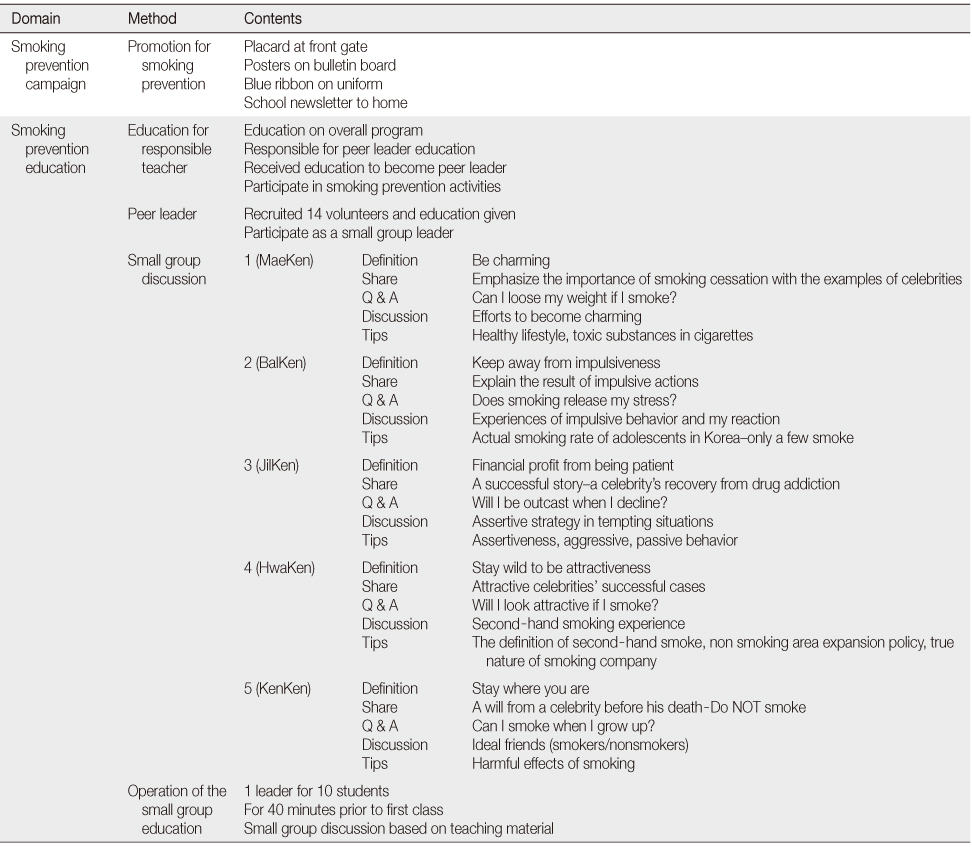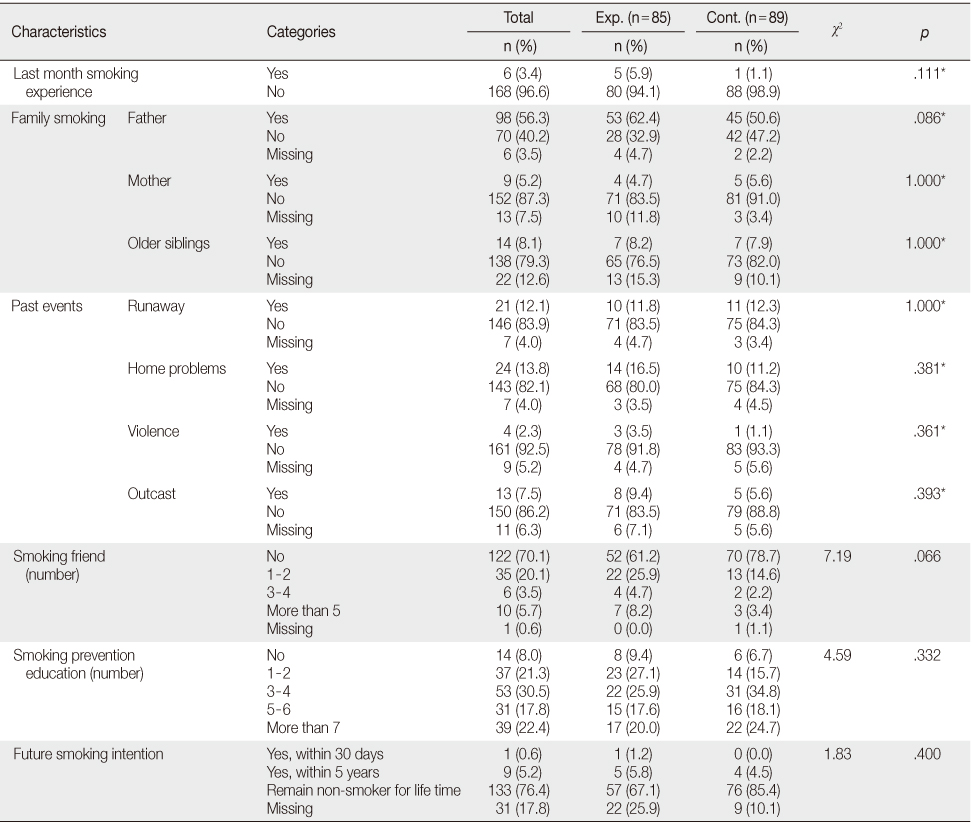Articles
- Page Path
- HOME > J Korean Acad Nurs > Volume 44(6); 2014 > Article
-
Original Article
- Effect of School-based Peer Leader Centered Smoking Prevention Program
- Sung Rae Shin, Pok Ja Oh, Hye Kyung Youn, Sun Hwa Shin
-
Journal of Korean Academy of Nursing 2014;44(6):649-659.
DOI: https://doi.org/10.4040/jkan.2014.44.6.649
Published online: December 31, 2014
1Department of Nursing, Sahmyook University, Seoul, Korea.
2Graduate School of Health Science & Social Welfare, Sahmyook University, Seoul, Korea.
3Graduate School of Division of Nursing Science, Ewha Womans University, Seoul, Korea.
- Address reprint requests to: Shin, Sun Hwa. Department of Nursing, Sahmyook University, 815 Hwarang-ro, Nowon-gu, Seoul 139-742, Korea. Tel: +82-2-3399-1593, Fax: +82-2-3399-1594, ffssh@hanmail.net
© 2014 Korean Society of Nursing Science
This is an Open Access article distributed under the terms of the Creative Commons Attribution NoDerivs License. (http://creativecommons.org/licenses/by-nd/4.0/) If the original work is properly cited and retained without any modification or reproduction, it can be used and re-distributed in any format and medium.
Abstract
-
Purpose
- The purpose of this study was to develop and evaluate a school-based peer leader centered smoking prevention program.
-
Methods
- Non-equivalent control group with a pre/post-test design was used. Students (n=174) in two boys' junior high schools located in D city, Korea participated with 85 being selected for the experimental group and 89 for the control group. Five sessions were given to the experimental group and a 50 minute lecture to the control group. Knowledge, attitude, non-smoking intention, and non-smoking efficacy were measured for the both experimental and control group at two weeks before the program and one month after the program was completed. Data were analyzed using χ2-test, Fisher's exact test, independent t-test and paired t-test with the SPSS 21.0 program.
-
Results
- The experimental group showed higher overall knowledge, negative attitude toward smoking, and higher non-smoking intention and efficacy. After receiving the school based peer leader centered smoking prevention program scores for attitude toward smoking and non-smoking efficacy increased in the experimental group were higher than in the control group.
-
Conclusion
- The school-based peer leader centered smoking prevention program needs longitudinal evaluation, but from this study, there is an indication that this program can be used with junior high school students and effectively change students' attitude toward smoking and promote non-smoking efficacy.
- 1. U.S. Department of Health and Human Services. Preventing tobacco use among youth and young adults: A report of the surgeon general, 2012. Atlanta, GA: U.S. Department of Health and Human Services, Centers for Disease Control and Prevention, National Center for Chronic Disease Prevention and Health Promotion, Office on Smoking and Health; 2012.
- 2. Korea Centers for Disease Control and Prevention. Community health survey, 2012 [Internet]. Chungcheongbuk-do, Author. 2013;cited 2013 August 24. Available from: http://www.cdc.go.kr/CDC/intro/CdcKrIntro0201.jsp?menuIds=HOME001-MNU0005-MNU0011&cid=20522
- 3. Korea Center for Disease Control and Prevention. The 2012 Korean youth risk behavior web-based survey [Internet]. Chungcheongbuk-do, Ministry of Education and Science Technology, Ministry of Health & Welfare, Korea Centers for Disease Control and Prevention. 2012;cited 2013 July 22. Available from: http://stat.mw.go.kr/front/statData/publicationView.jsp?bbsSeq=13&nttSeq=20652&menuId=47
- 4. Park E. School-based smoking prevention programs for adolescents in South Korea: A systematic review. Health Educ Res. 2006;21(3):407–415. http://dx.doi.org/10.1093/her/cyl038ArticlePubMed
- 5. Dobbins M, DeCorby K, Manske S, Goldblatt E. Effective practices for school-based tobacco use prevention. Prev Med. 2008;46(4):289–297. http://dx.doi.org/10.1016/j.ypmed.2007.10.003ArticlePubMed
- 6. Botvin GJ. Life skills training: Promoting health and personal development level 2. Princeton, NJ: Princeton Health Press; 2000.
- 7. Sussman S, Dent CW, Stacy AW, Sun P, Craig S, Simon TR, et al. Project towards no tobacco use: 1-year behavior outcomes. Am J Public Health. 1993;83(9):1245–1250.ArticlePubMedPMC
- 8. Sussman S, Miyano J, Rohrbach LA, Dent CW, Sun P. Six-month and one-year effects of project EX-4: A classroom-based smoking prevention and cessation intervention program. Addict Behav. 2007;32(12):3005–3014. http://dx.doi.org/10.1016/j.addbeh.2007.06.016ArticlePubMedPMC
- 9. Park SW, Lee JY, Park JH. Evaluation of the effects of a smoking prevention program for Korean high school students. J Korean Soc Health Educ Promot. 2004;21(1):153–170.
- 10. Bosi S, Gorini G, Tamelli M, Monti C, Storani S, Carreras G, et al. A school-based peer-led smoking prevention intervention with extracurricular activities: The LILT-LdP cluster randomized controlled trial design and study population. Tumori. 2013;99(5):572–577. http://dx.doi.org/10.1700/1377.15304ArticlePubMedPDF
- 11. Kim Y, Park I, Park JS. Meta-analysis of effects on adolescent smoking cessation programs in Korea. J Korean Acad Nurs. 2008;38(2):204–216. http://dx.doi.org/10.4040/jkan.2008.38.2.204Article
- 12. Chun JS, Kim J. A review of research on smoking prevention and cessation programs for adolescents. J Adolesc Welf. 2014;16(1):305–326.
- 13. Kim IH. The effect of smoking prevention program on changing the knowledge and attitude about smoking behavior of middle school boy's. J Korean Community Nurs. 2003;14(2):242–252.
- 14. Kim YS, Jeong BR. An analysis of articles related to smoking and smoking cessation of Korean adolescents. J Korean Acad Community Health Nurs. 2010;21(1):53–62. http://dx.doi.org/10.12799/jkachn.2010.21.1.53Article
- 15. Kim HO. A study on the smoking related social influence, refusal skill and nonsmoking related self-efficacy among adolescents. Korean J Child Health Nurs. 2003;9(3):237–249.
- 16. Maxwell KA. Friends: The role of peer influence across adolescent risk behaviors. J Youth Adolesc. 2002;31(4):267–277. http://dx.doi.org/10.1023/A:1015493316865ArticlePDF
- 17. Kremers SP, Mudde AN, de Vries H. Subtypes within the precontemplation stage of adolescent smoking acquisition. Addict Behav. 2001;26(2):237–251.ArticlePubMed
- 18. Jee YO. Testing the theory of planned behavior in the prediction of smoking cessation behavior among military smokers [dissertation]. Seoul, Yonsei University. 1994.
- 19. Plummer BA, Velicer WF, Redding CA, Prochaska JO, Rossi JS, Pallonen UE, et al. Stage of change, decisional balance, and temptations for smoking: measurement and validation in a large, school-based population of adolescents. Addict Behav. 2001;26(4):551–571.PubMed
- 20. Sohn EJ. The comparison of family environment, smoking experience and psychosocial characteristics of middle school student [master's thesis]. Seoul, Sahmyook University. 2006.
- 21. Paek KS. The effects of smoking prevention education on the smoking cessation intention and knowledge and attitude toward smoking among male middle school students. J Korean Community Nurs. 2005;16(1):32–39.
- 22. Ewles L, Simnett I. Promoting health: A practical guide. 5th ed. London, UK: Ballierre Tindall; 2009.
- 23. Daewoong Pharmaceutical Co. Ltd. Nico free school project. Seoul: Korean Association on Smoking and Health; 2007.
- 24. Choi YM. The effect of the educational program based upon experiment to prevent smoking in middle school students [master's thesis]. Seoul, Kyung Hee University. 2004.
- 25. Park IH, Park JS, Kim YK. Meta-analysis of effects on smoking prevention programs for the adolescent in Korea. J Korean Soc Health Educ Promot. 2006;23(3):1–16.
- 26. Vartiainen E, Pennanen M, Haukkala A, Dijk F, Lehtovuori R, De Vries H. The effects of a three-year smoking prevention programme in secondary schools in Helsinki. Eur J Public Health. 2007;17(3):249–256. http://dx.doi.org/10.1093/eurpub/ckl107ArticlePubMed
- 27. Ajzen I, Fishbein M. Understanding attitudes and predicting social behavior. Englewood Cliffs, NJ: Prentice-Hall; 1980.
- 28. Shin SR, Jeong GC. Predictive variables on intention to stay as a nonsmoker based on educational environment related factors. Health Soc Sci. 2007;21:5–24.
- 29. Oh H, Jeong H, Seo W. Integrative smoking cessation stage model for Chinese students studying in Korea. Asian Nurs Res (Korean Soc Nurs Sci). 2013;7(4):182–190. http://dx.doi.org/10.1016/j.anr.2013.09.001ArticlePubMed
- 30. Shin SR, Shin SH, Lee BK, Yang JH. Influence of experiences of witnessing tobacco advertising and preferences of tobacco companies' social responsibility on current and future smoking intentions in adolescents. J Korean Acad Community Health Nurs. 2014;25(1):33–43. http://dx.doi.org/10.12799/jkachn.2014.25.1.33Article
REFERENCES

O1=General characteristics, knowledge of smoking, attitude toward smoking, non-smoking intention, non-smoking efficacy; X1=School based peer leader centered smoking prevention program; X2=Lecture on smoking prevention for 50 minutes; O2=Knowledge of smoking, attitude toward smoking, non-smoking intention, non-smoking efficacy.
Figure & Data
REFERENCES
Citations

- The development and evaluation of an I-message smoking prevention program for high school students: A randomized controlled trial
Song Hwa Chae, Bu Kyung Park
The Journal of Korean Academic Society of Nursing Education.2025; 31(2): 161. CrossRef - Adolescents encouraging healthy lifestyles through a peer‐led social marketing intervention: Training and key competencies learned by peer leaders
Elisabet Llauradó, Magaly Aceves‐Martins, Jordi Prades‐Tena, Maria Besora‐Moreno, Ignasi Papell‐Garcia, Montse Giralt, Amy Davies, Lucia Tarro, Rosa Solà
Health Expectations.2022; 25(1): 455. CrossRef - The effects of smoking cessation program using breath-mindfulness meditation
Hyeon-Ah Cho
Korean Journal of Health Education and Promotion.2021; 38(3): 23. CrossRef - Effects of a Strength Based I-Change Smoking Cessation Program for Smoking Middle School Boys
Jung Hee Kim, Yeon Hee Choi
Journal of Korean Academy of Nursing.2017; 47(2): 164. CrossRef - Daily Smoking Girls' Tobacco Use, Health Behaviors and Family Factors : Analysis of 2015 Korean Youth Risk Behavior Web-based Survey
Youngjin Lee
Journal of Digital Convergence.2016; 14(5): 377. CrossRef - The effect of Community Mapping based on Volunteered Geographic Information System on Smoking Prevention among Female Middle School Students
Hyunmi Son, Miyoung Jung, Yunkyung Hong
Journal of the Korean Society of School Health.2016; 29(3): 286. CrossRef
Research Design
O1=General characteristics, knowledge of smoking, attitude toward smoking, non-smoking intention, non-smoking efficacy; X1=School based peer leader centered smoking prevention program; X2=Lecture on smoking prevention for 50 minutes; O2=Knowledge of smoking, attitude toward smoking, non-smoking intention, non-smoking efficacy.
School based Peer Leader Centered Smoking Prevention Program
Homogeneity Test between Experimental and Control Group (N=174)
*Fisher's exact test; Exp.=Experimental group; Cont.=Control group.
Baseline Outcome Measures between Experimental and Control Group (N=174)
Exp.=Experimental group; Cont.=Control group.
Differences of Variables between Experimental and Control Group (N=174)
Exp.=Experimental group; Cont.=Control group.
O1=General characteristics, knowledge of smoking, attitude toward smoking, non-smoking intention, non-smoking efficacy; X1=School based peer leader centered smoking prevention program; X2=Lecture on smoking prevention for 50 minutes; O2=Knowledge of smoking, attitude toward smoking, non-smoking intention, non-smoking efficacy.
*Fisher's exact test; Exp.=Experimental group; Cont.=Control group.
Exp.=Experimental group; Cont.=Control group.
Exp.=Experimental group; Cont.=Control group.
 KSNS
KSNS
 E-SUBMISSION
E-SUBMISSION




 Cite
Cite

